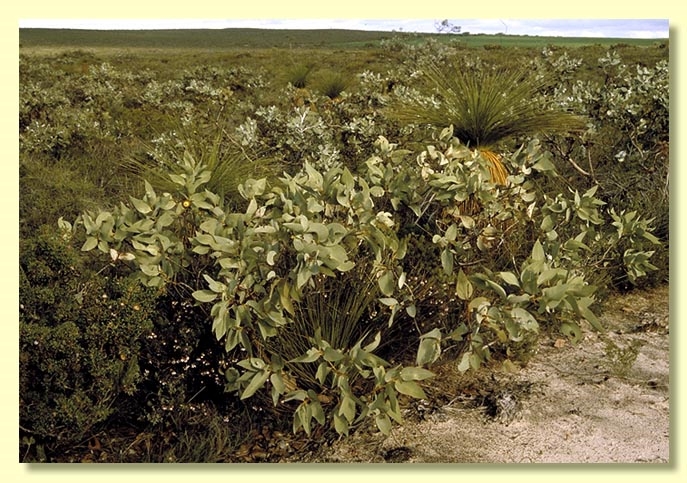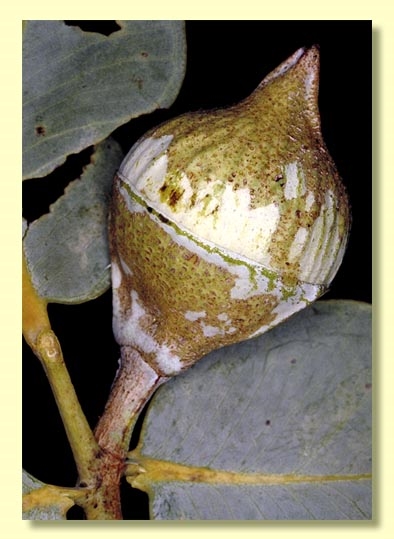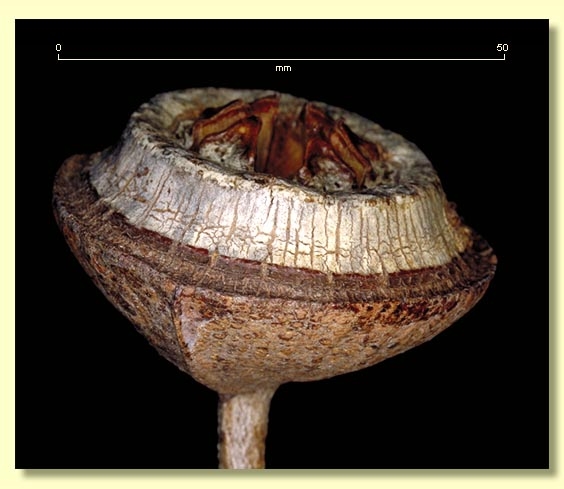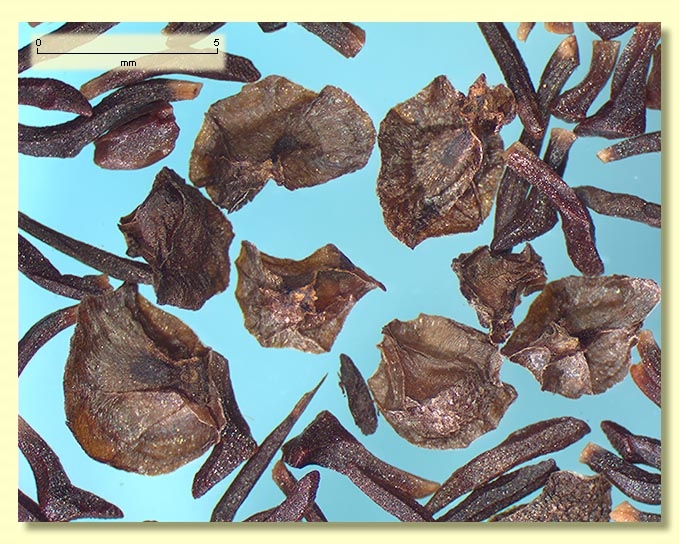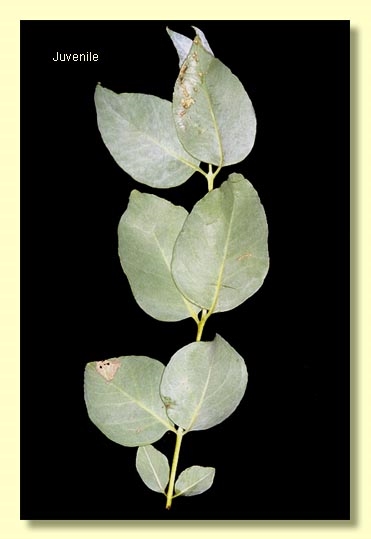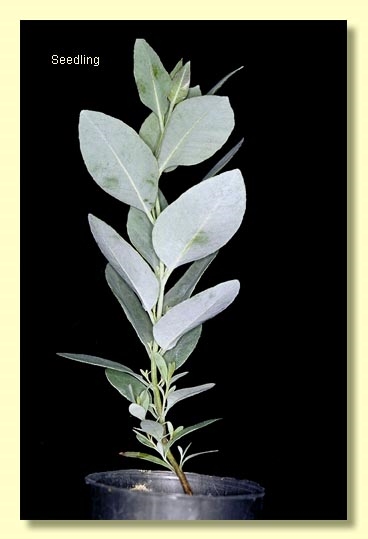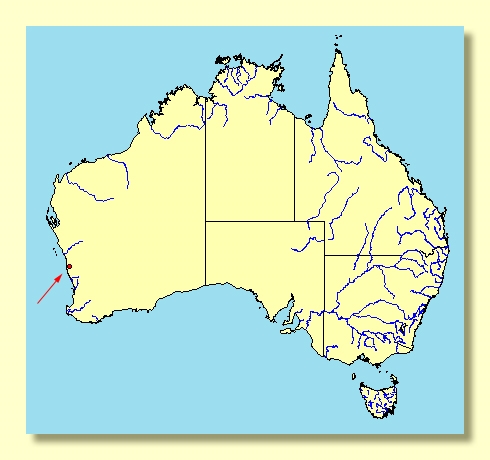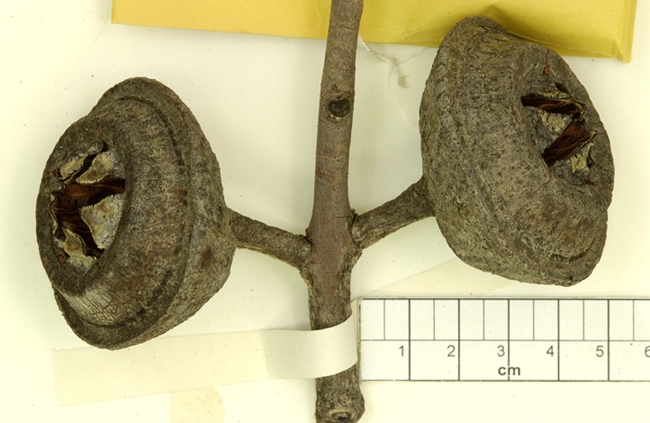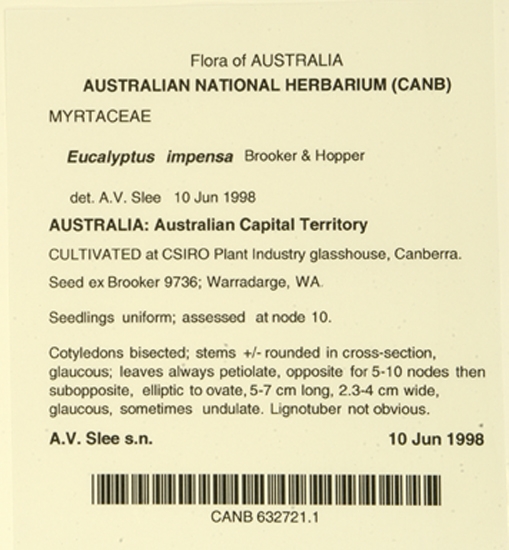Eucalyptus | Symphyomyrtus | Bisectae | Destitutae | Curviptera | Xylocarpae
Euclid - Online edition
Eucalyptus impensa
Bark smooth throughout, grey and brown to coppery.
Branchlets lacking oil glands in the pith.
Juvenile growth (coppice or field seedlings to 50 cm): stems rounded in cross-section; juvenile leaves always petiolate, opposite to sub-opposite, broadly ovate, 6–11 cm long, 4.5–6.5 cm wide, dull, green to bluish green, new growing tips only glaucous.
Adult leaves stiff, opposite to sub-opposite, petioles thick, rarely absent, 0–1 cm long; blade ovate to broadly lanceolate, 10.5–14 cm long, 4–8 cm wide, base tapering to petiole or rounded, margin entire, apex acute, dull, light green, side-veins greater than 45° to midrib, reticulation moderate to dense, intramarginal vein remote from margin, oil glands obscure.
Inflorescence axillary unbranched, peduncles 1.5–2 cm long; bud solitary, sessile or stoutly pedicellate, (pedicels 0–1 cm long). Mature buds ovoid to more or less globular (4–5 cm long, 2.5–3.5 cm wide), glaucous or not, sometimes shallowly ribbed, scar present, operculum beaked (2.5 cm long), outer stamens oblique, inner stamens inflexed, anthers cuboid, versatile, dorsifixed, dehiscing by longitudinal slits, style long and straight, stigma blunt to rounded, locules 5 or 6, the placentae each with 8 or 10 vertical rows of ovules. Flowers pink.
Fruit sessile to pedicellate (pedicels 0–1.5 cm long), shallowly hemispherical, 2–3 cm long, 4.8–5.5(6) cm wide, disc broad, ascending obliquely then dipping slightly towards centre, valves 5 or 6, exserted.
Seeds grey-brown, 4.5–6.5 mm long, obliquely pyramidal with ridged faces, an encircling marginal flange ca 1 mm wide, dorsal surface smooth to shallowly reticulate, hilum terminal.
Cultivated seedlings (measured at node 10): cotyledons Y-shaped (bisected); stems rounded in cross-section; leaves opposite becoming sub-opposite, always shortly petiolate, ovate to elliptic, 5–7 cm long, 2–4 cm wide, dull, glaucous, sometimes undulate.
Flowering has been recorded in May and June.
A shrub or dwarf mallee endemic to Western Australia, from the sandplain south-west of Eneabba. The stems are smooth and the leaves of the adult plant are juvenile, opposite to sub-opposite, petiolate, ovate, glaucous.
Eucalyptus impensa belongs in Eucalyptus subgenus Symphyomyrtus section Bisectae subsection Destitutae because buds have two opercula, cotyledons are Y-shaped and branchlets lack oil glands in the pith. Within this subsection E. impensa is in series Curviptera, one of about 30 closely related species and subspecies which are further characterised by having large buds in umbels of one, three or seven, staminal filaments erect or oblique (rarely inflexed) in bud, and large fruit usually with an ascending disc and exserted valves. Several of these species are noted for their large-leaved crowns made up of juvenile leaves.
E. impensa is distinguished from closely related single-budded species E. macrocarpa and E. rhodantha by having large petiolate non-glaucous leaves and stoutly petiolate buds on peduncles to 2 cm long. E. macrocarpa has glaucous sessile stem clasping leaves and non-pedicellate buds with the peduncle 0.1–1 cm long. E. rhodantha has sessile glaucous stem clasping leaves, though a few shortly petiolate leaves may be present, and stoutly pedicellate buds on down-turned peduncles to 3.3 cm long. Flowers in E. impensa are pink, those of E. rhodantha and E. macrocarpa are red or rarely creamy white.
E. impensa grows with two large-leaved glaucous species of eucalypt—E. macrocarpa and E. pleurocarpa—in sandplain heath. It is only superficially similar to E. pleurocarpa, a species in Eucalyptus subgenus Eudesmia with 'square' stems, buds with sepals and whose flowers are white with the stamens held in four bundles.
Eucalyptus impensa is listed as "Endangered" under the Australian Government Environment Protection and Biodiversity Conservation Act 1999 (EPBC Act). Further information may be found at this web address:
http://www.environment.gov.au/cgi-bin/sprat/public/sprat.pl

